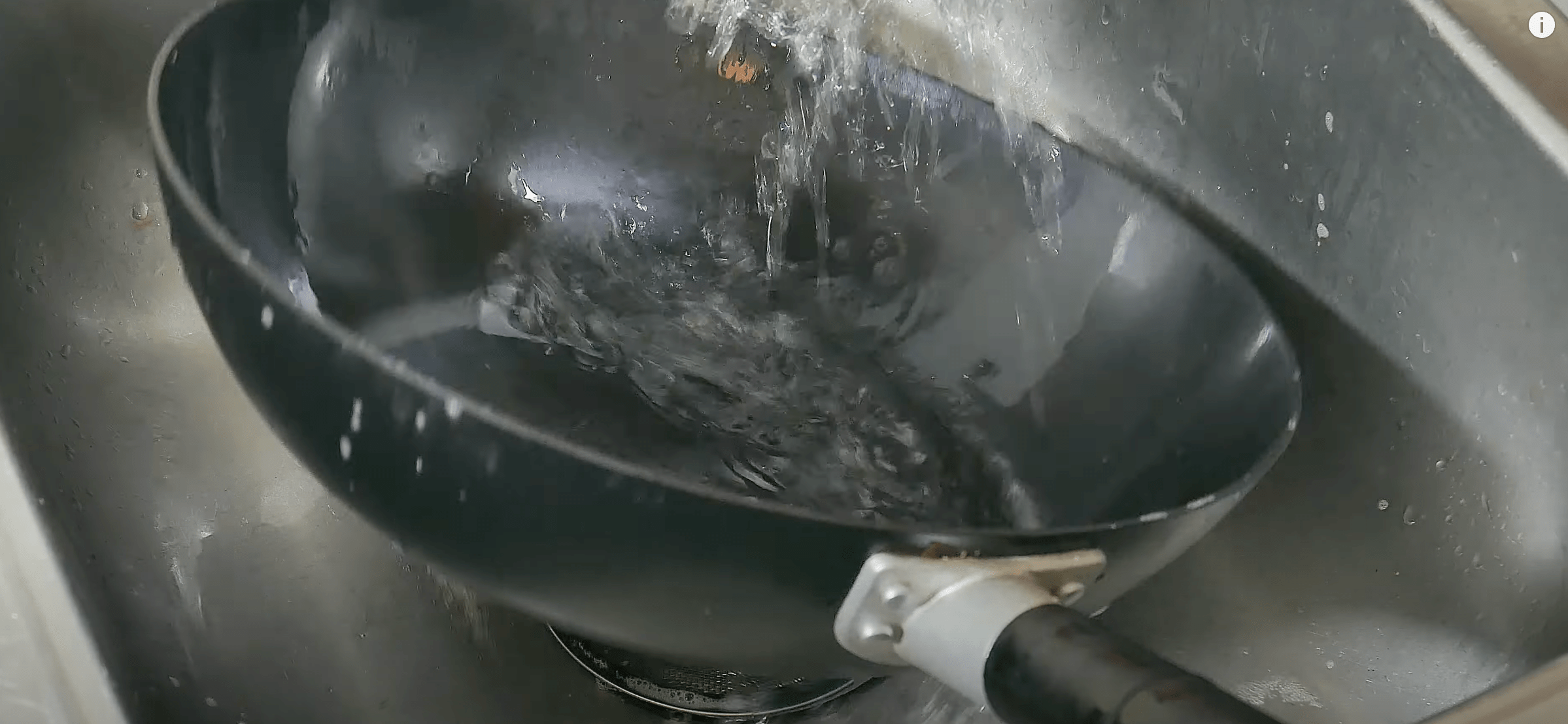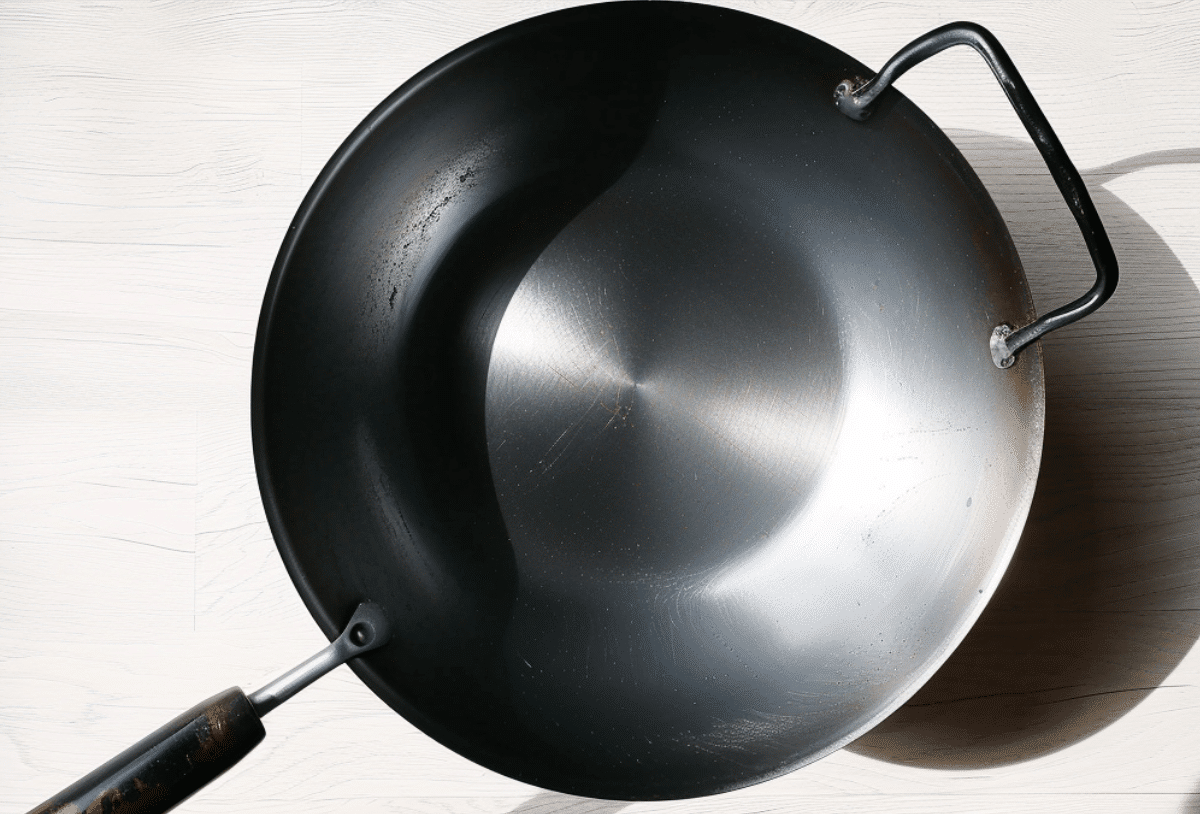Are you ready to unlock the secrets of seasoning your carbon steel Wok to perfection?
This comprehensive guide will help you transform your new wok into a reliable, non-stick, and rust-resistant kitchen companion.
Following these simple techniques, you can create delicious stir-fries and other dishes that impress your family and friends.
Plus, with proper care and maintenance, your trusty wok will last for years, making it an invaluable addition to your cooking arsenal.
So, let’s dive in and discover everything you need about seasoning your wok like a pro!
How to Season a Wok: Stepwise Guide
1. Initial Cleaning
Removing the manufacturer’s coating from your new wok is crucial before seasoning. This step ensures food safety and allows for optimal seasoning.
Start by washing your wok thoroughly with hot water and mild dish soap. Use a soft sponge or a scrub pad to avoid scratching the surface.
Once clean, dry your wok completely with a clean kitchen towel or paper towel to prevent rust formation.
2. Heating the Wok
Heating your Wok is the first step in the seasoning process. It opens up the pores of the carbon steel, allowing the oil to penetrate and create a protective layer.
Place your wok on the stove over high heat until it begins to smoke and changes color. It will turn dark blue or black, indicating it’s ready for the next step.
To ensure even heating, rotate the wok on the burner and tilt it to heat the sides.
3. Applying Oil

For seasoning your wok, choose an oil with a high smoke point, such as vegetable, canola, or peanut oil.
Pour a small amount of oil into the heated wok and use a paper towel to spread it evenly across the entire surface, including the sides.
Be careful, as the wok will be hot. Continue heating the oiled wok until it starts smoking, then remove it from the heat and let it cool down.
4. Cooling and Repeating
After applying the oil, let your wok cool down completely before proceeding. Once cooled, wipe off any excess oil with a clean paper towel.
Repeat the oiling and heating process at least twice to achieve a durable, non-stick surface. After the final round, your Wok is ready for use.
Store it in a dry place, and remember to clean it with hot water and a soft sponge after its first use.
Care for A Seasoned Wok: Maintenance After Use
Proper maintenance is key to extending the life of your carbon steel wok and preserving its excellent cooking qualities.
By following a few simple steps after each use, you can ensure that your Wok remains non-stick, rust-free, and ready to create delicious meals for years to come.
Maintaining your Wok is an ongoing process that builds upon the initial seasoning, guaranteeing optimal performance and longevity.
1. Cleaning the Wok Post-Cooking

Clean your wok immediately after cooking to remove food particles and prevent rust formation.
While the wok is still hot, rinse it with hot water and gently scrub away any stuck-on food with a soft brush or sponge.
Avoid using soap, as it can strip away the hard-earned patina. You can boil water in the wok and then scrub gently for stubborn bits.
After cleaning, dry your wok thoroughly by placing it over low heat on the stove until all moisture has evaporated.
2. Re-Oiling the Wok
After cleaning and drying, it’s essential to re-oil your Wok to create a protective barrier that maintains its non-stick surface and prevents rust.
Using a paper towel, apply a thin layer of oil (such as vegetable, canola, or peanut oil), covering the entire surface, including the sides and bottom of the wok.
Heat the wok over medium-low heat for a few minutes to allow the oil to penetrate the surface. Then, please remove it from heat and wipe away any excess oil with a clean paper towel.
3. Storing the Wok
Store your Wok in prime condition in a dry place, away from moisture and humidity. Ensure the wok is completely cool and properly oiled before storing it to prevent rust.
If you don’t plan on using your wok frequently, consider applying a thicker layer of oil before storage.
Additionally, it’s a good idea to periodically bring your wok out of storage, re-oil it, and heat it briefly to maintain its seasoning and prevent rust.
Why Season a Wok: Benefits of Seasoning
Seasoning a wok is a fundamental process that is essential across many cooking cultures. It involves creating a protective layer on the wok’s surface that offers three core benefits.
1. A Non-Stick Surface
One of the primary advantages of a well-seasoned wok is its natural non-stick surface. This allows you to cook with less oil, promoting healthier meals without worrying about food sticking to the pan.
2. Rust Prevention
Additionally, the protective patina created during seasoning is a barrier against moisture, preventing rust and extending the lifespan of your Wok.
3. Flavor Enhancement
Finally, a seasoned wok contributes to the unique depth of flavor in dishes, known as “wok hei” or the “breath of the wok.” It imparts a subtle smoky essence that enhances the taste of your culinary creations.
By seasoning your wok properly, you’ll enjoy a more efficient and enjoyable cooking experience while prolonging the life of your trusty kitchen companion.
Choosing the Right Wok: Factors for Selection
Before diving into the seasoning process, choosing the right wok is crucial. The key factors to consider include the following.
- Wok’s material: Carbon steel is often preferred for Woks due to its durability, heat responsiveness, and ability to develop a natural, non-stick patina.
- Compatibility with your stove: When selecting a wok, ensure its bottom is suitable for your stove type—flat bottoms are suitable for electric or induction stoves, and round bottoms are ideal for gas stoves.
- Weight: Consider the wok’s weight. A lighter Wok is easier to maneuver, but a heavier one may offer better heat retention.
- Handle design: Look for handles that secure grip and stay cool during cooking.
Each of these elements plays a significant role in your overall cooking experience and the success of your seasoning efforts.
Troubleshooting and Common Issues
Identifying Problems
Even with the best intentions, wok users may encounter challenges during seasoning and daily use.
Some common issues include uneven seasoning, rust formation, and maintenance mistakes.
Recognizing these problems early on is key to maintaining the quality and longevity of your Wok.
Solutions and Preventative Measures
To achieve an even patina, apply oil consistently across the entire surface of the wok during seasoning.
If rust spots appear, remove them with fine steel wool and re-season the affected area.
Avoid common maintenance mistakes by always drying your wok thoroughly after washing and applying a thin layer of oil before storage.
Regular use and proper care will help prevent these issues from occurring.
Best Practices for Cooking with Your Seasoned Wok
Once your wok is seasoned, it must be used correctly to maintain its patina and unlock its full potential.
Regular use helps preserve the seasoning and enhances the wok’s non-stick properties and overall performance.
A seasoned wok is incredibly versatile, allowing you to explore various cooking techniques such as stir-frying, deep-frying, and steaming.
Cook dishes high in fat and protein, such as stir-fried meats and vegetables, to build and maintain the patina.
Avoid acidic ingredients like vinegar or tomatoes, as they can weaken the patina.
With proper use and care, your seasoned wok will become an indispensable tool in your kitchen, delivering delicious meals for years.
Conclusion
In conclusion, seasoning your carbon steel wok is a simple yet essential process that transforms it into a reliable, non-stick, flavor-enhancing kitchen companion.
By following the steps outlined in this guide, you’ll be able to create a durable patina that not only prevents rust but also contributes to the unique “wok hei” taste in your dishes.
Remember to choose the right Wok for your needs, maintain it properly after each use, and cook with it regularly to maximize its potential.
With a well-seasoned wok, you can explore various cooking techniques and create delicious meals for years.
So, grab your wok, season it to perfection, and embark on a culinary journey that will take your stir-fry game to the next level!
Frequently Asked Questions
What Happens if You Don’t Season a Wok?
If you don’t season a wok, food will stick to the surface, the wok will be prone to rust, and you won’t get the authentic smoky “wok hei” flavor.
How Do You Tell if A Wok Is Properly Seasoned?
A properly seasoned wok will have a dark, smooth, and glossy non-stick surface. Water droplets should roll around when the wok is heated and evaporate quickly.
What Oil Is Best for Seasoning a Wok?
For seasoning a wok, use an oil with a high smoke point, such as vegetable, canola, or peanut oil. Avoid oils with low smoke points, like olive oil.




